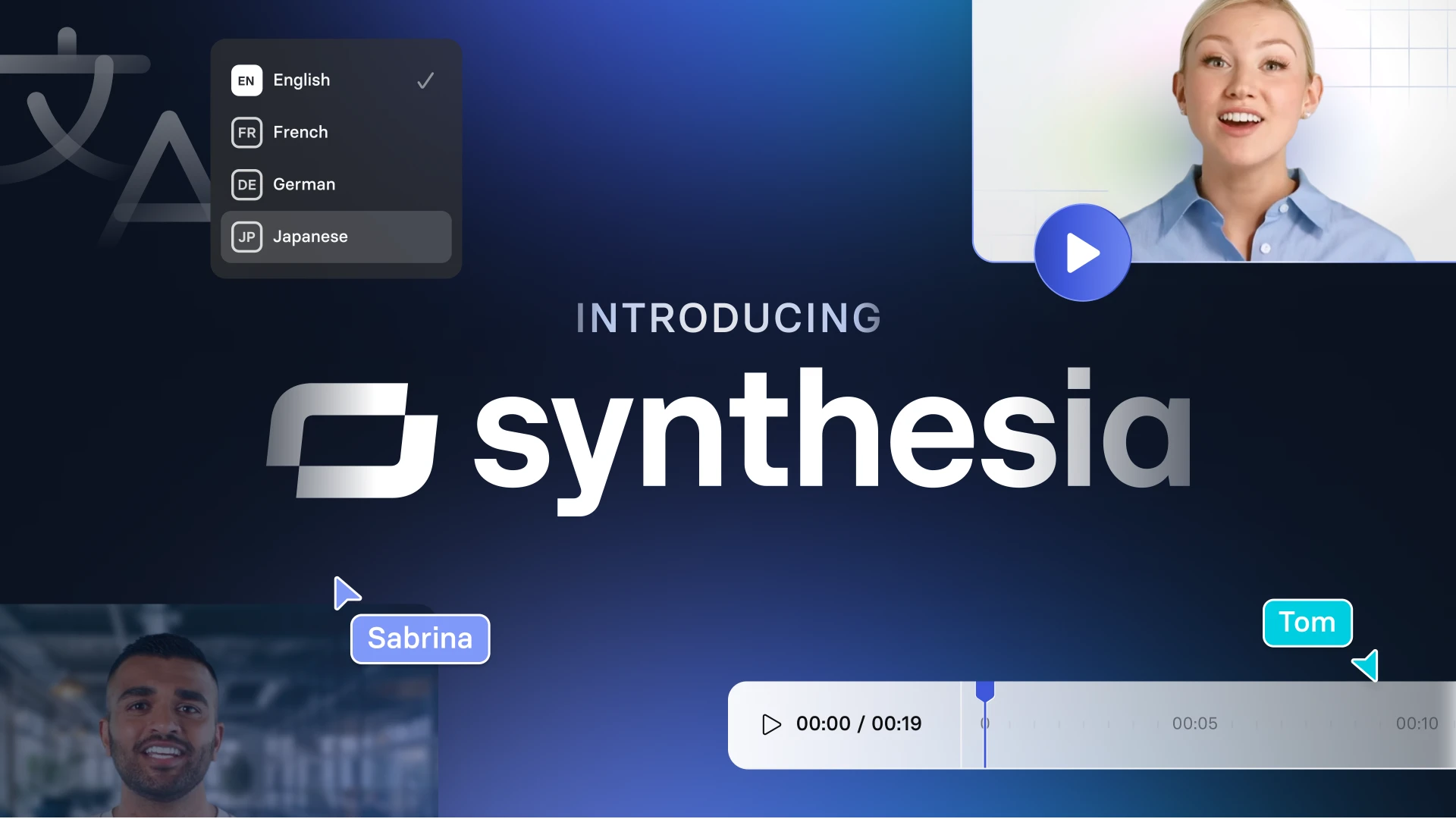
Lost in translation no more. Now our platform can localize videos instantly with one click.
Create AI videos with 230+ avatars in 140+ languages.
- Synthesia has reached a major milestone: 1 million people are using our platform to create content in over 130 languages
- To better support their needs, we’re building the world’s first video localization solution available in the Synthesia 2.0 platform
- 1-click Translation delivers instant, AI-powered translations of a video created in Synthesia, with easy-to-use versioning control and live collaboration.
- Multilingual Video Player allows translated versions of a video to be played in multiple languages with one click
- AI-enhanced video dubbing translates content from any source with perfect lip-sync and a natural-sounding voice
We believe that video can be the universal language of communication. Video is a format we all understand and use, no matter where we come from, what industry we work in, what education we have, or what content we consume.
From online tutorials and webinars to blockbuster movies and viral social media clips, video content engages audiences in ways that text simply cannot. It’s more immersive, more dynamic, and more effective at conveying information, emotion and culture. Yet, despite its many advantages, video still faces a significant challenge: language barriers.
While the global reach of platforms like YouTube, TikTok, and Netflix has democratized access to video content, it has also highlighted a crucial gap. A video produced in one language is often inaccessible to those who don’t speak that language, severely limiting its potential audience.
Traditional methods of translation—subtitling, dubbing, and voiceover—are not only time-consuming but also expensive and resource-intensive. For creators and companies aiming to scale their content globally, this presents a significant financial and operational obstacle. According to CSA Research, 87% of consumers won’t buy from an English-only website. This means you could miss out on important business opportunities by not localizing your content.
And while translation is a significant part of the localization process, it’s not the only one: in most cases, a literal translation for videos can miss cultural cues, resulting in content that not only does not appeal to audiences but can be awkward, inappropriate or offensive. For example, the American ad "Make us your top draft pick" might not be understood outside the US, where the draft is not a common concept. Localization considers the culture of the target region and the nuances of language that relate to that culture. It aims to adapt the content so that it looks and feels as native as possible, and resonates with the audience in the new culture.
Until now, localizing videos has been a time-intensive, manual process. You need to write the script, record the video with an actor, edit the video in post-production, hire an agency to translate the video, hire an actor to do the voiceover in another language, and edit the video again if there is any text on the screen. Lastly, and very importantly, you have to figure out how to deliver the video to the targeted audience that wants to watch it in their specific language.
Speaking the language of our 1 million creator community
At Synthesia, we want to create a new and better way of localizing content because we believe that soon every video should be available in any language by default. We now have over 1 million users around the world, creating content in over 130 languages.

To better support their needs, we’re building the world’s first video localization solution available in our Synthesia 2.0 platform. Here are the first features we’re working on that we believe will change the entire process of localizing content and distributing it to a global audience.
1-Click Translation in Synthesia
Imagine you have built a SaaS solution for time management. You have users in seven countries (and growing) with different levels of computer literacy and various titles, but they all share the same goal — spend their time effectively. You need to make the app very easy to use.
You create a help center video using one of our Expressive Avatars or the Personal Avatar of one of your employees for a more personalized touch. Once the video is done, you translate it into seven languages instantly. Our 1-click translation feature doesn’t just translate the script, it also takes care of any text you’ve used in your video. So if you’ve placed any text boxes in your scenes, they will be automatically translated too which removes a lot of the manual work in localizing content.
Nicely done! But it’s not enough, right? We need to make sure that the content was translated correctly.
Live Collaboration on translations
You can easily invite a third party such as a translation services company to ensure the translation is accurate and the content is locally relevant.
They will leave comments, edit the video, and make sure your content is perfectly localized.
All translated versions in Synthesia are connected to the main video created in the original language.
AI-powered localization
AI really shines when it comes to creating hyper-localized content: not only can you translate the video with one click in Synthesia, you can also rely on our rich database of AI avatars and other media capabilities to really localize your video for your target audience.
Say for example, you made that customer support video in English using a Personal Avatar of an associate from your UK office. If you want to make a version for your Japanese customers, you simply translate the video into Japanese in Synthesia just like before, but then swap out your UK team member’s Personal Avatar for one of your colleagues in the Japanese office to add that extra personalization touch.

You can also replace other elements in the video to make it more culturally relevant, such as the background (continuing on the theme above, swap the UK office background photo for one of the Japanese office) or other visual assets.
Now that the video is done, let's make sure we publish it with all translations. Don't forget to add automatically generated captions so your viewers can be flexible about how they watch the video.
Introducing the new Multilingual Video Player in Synthesia
The videos are ready, generated, and shining bright — it's time to publish them and get them in front of your audience. You can choose to download the videos and upload them on a video sharing platform such as YouTube or Vimeo.
But if you’re thinking about owning distribution, you can embed Synthesia’s video player on your website — for example in your help center. The video player can be customized to include your company’s logo and call-to-action messages or other relevant copy.

For those interested in using our video player, we have an exciting update to share: we’re releasing a new version of our video player called the Multilingual Video Player which is launching to all enterprise users as of today.
Just share the link to your video or embed it anywhere, and the Multilingual Video Player will let your viewers watch the original video in all the languages you translated it to.
The Multilingual Video Player also automatically loads the video in the viewer’s preferred language based on the settings in the web browser.
And if you make any changes to your video and its translations, just republish it, and we will make sure your content is updated everywhere. How cool is that?
AI-enhanced video dubbing
But what about content that everyone has been creating before AI videos became a thing? We believe it shouldn't be left out; instead we want to help localize those videos too.
For example, let's take a product demo or an all-hands presentation. You can upload it to Synthesia, pick any of the supported languages on our platform, and enable the Multilingual Video Player.
Now your audience can watch the same content natively in other languages. Thanks to our EXPRESS-1 model, the presenter can speak French to French speakers by default, with perfect lip-sync and a natural-sounding voice, giving viewers a more culturally relevant and engaging experience.
Here is a AI dubbed video featuring David Beckham we produced for the Malaria Must Die campaign:
You can try out our AI dubbing for free by uploading a video file. Alternatively you can translate a YouTube video.
The impact on global content distribution
Studies have shown that any content that is locally targeted has six times more engagement than content that is not designed for the global market. You gain a lot in loyalty, engagement, and scalability when your content is available in the viewer's preferred language. The film and entertainment industry knows this, which is why in 2021 Netflix dubbed 5 million minutes of content which resulted in an increase by 120% in viewership.
But other companies don’t have the resources to dub content at scale, which is where Synthesia comes in. By dramatically reducing the time and cost associated with video translation, we’re enabling content creators to reach global audiences like never before. Educational institutions can now offer courses in multiple languages, expanding access to knowledge across borders. Businesses can communicate with international customers more effectively, fostering stronger global connections. Media companies can localize their content more rapidly, staying ahead in the competitive streaming market.
Furthermore, this technology empowers creators from non-English-speaking regions to share their stories with the world. It levels the playing field, ensuring that content is no longer confined by language but can instead travel freely, connecting people across cultures and continents.
The future of multilingual video
As we continue to refine and expand the capabilities of our Synthesia 2.0 platform, the future of video content looks increasingly borderless. We envision a world where language is no longer a barrier to understanding, where every video, no matter its origin, is accessible to anyone, anywhere, in their own language.
In an age where video is the fastest-growing medium, our AI technology is not just a tool for translation—it’s a catalyst for a more interconnected world. We are excited to be at the forefront of this transformation, helping to make the world a little smaller and a lot more connected.
Stay tuned as we continue to push the boundaries of what’s possible with generative AI, bringing the world closer together, one video at a time.
Thanks to Anton Bondarenko, senior product manager at Synthesia, for his contributions to this article.
About the author
Senior Product Manager
Armughan Ahmad Khan
Armughan Ahmad Khan is a Senior Product Manager at Synthesia.










.png)


